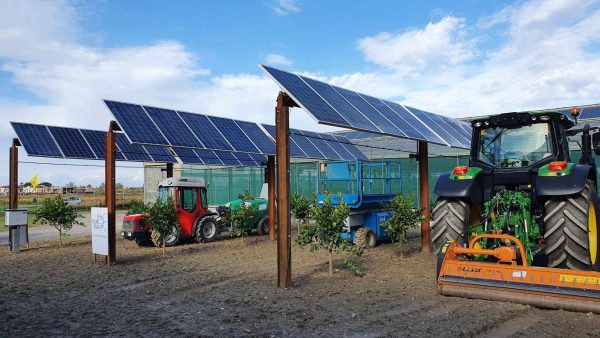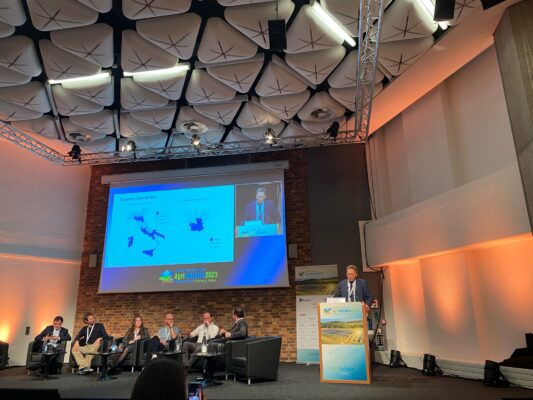
“Agrivoltaics must represent a transversal model, as it is strategic for the international energy transition process and also capable of adapting to the needs of innovation and decarbonization in agriculture”
AGRIVOLTAICS AS A DRIVER OF EUROPE’S ENERGY TRANSITION
Increasing renewable energy production is a strategic objective that Italy is urged to pursue more vigorously. In particular, boosting electricity generation from solar sources, which is confirmed as a driver for renewables, is crucial in making rapid strides in the decarbonization process. In this regard, one of the main challenges is to combine energy needs with the historical agricultural vocation of our country. In response to this need, agrivoltaics, a strategic solution for combining electricity generation with agricultural activities, is becoming increasingly widespread. EF Solare Italia has focused on agrivoltaics from the beginning because of its unique ability to create value while protecting the environment.

A recent study by the European Union’s Joint Research Center reports that it would be enough to dedicate just 1 percent of Europe’s agricultural land to the installation of agrivoltaic systems to add nearly 1 TW of new renewable capacity, significantly surpassing development goals for 2030 and almost zeroing out land use.
Agrivoltaics is also an important lever for improving the acceptance of photovoltaics by local communities, especially when combined with proper communication of the social, economic, and environmental benefits of this technology. A not insignificant consensus issue to be addressed in an increasingly effective way, in synergy with institutions and operators in the sector.
EF Solare Italia’s extensive experience, which began more than 10 years ago with the management of 32 MW of photovoltaic greenhouses, has laid the groundwork for the evolution of the new elevated agrivoltaic model. This format makes it possible to build plants consistent with the latest ministerial guidelines: characterized by elevated structures, ground-mounted without the use of concrete, solar tracking technology, and irrigation and monitoring systems for electricity production, land, and crops. To enable the effective integration of this and other forms of agrivoltaics into the energy system, it is critical to ensure that the definitions of different agrivoltaic configurations are consistent with decarbonization goals. Indeed, we believe that clear and comprehensive regulation that rewards the positive externalities of agrivoltaic systems is a crucial factor in fully exploiting the sector’s great potential.

For this reason, EF Solare Italia routinely takes part in national and international discussions, also participating in research and projects at the European level, which confirm the Group’s role as an industrial protagonist. Thanks to its extensive knowledge of the sector, EF Solare Italia takes part in the European research project Symbiosyst, to define best practices and increase the competitiveness of agrivoltaics in Europe. The project partners have recently published a position paper dedicated precisely to pointing out the key elements to be considered at the basis of regulatory activity, in order to consolidate the important progress already made by the sector and achieve the challenging goals that agrivoltaics sets for itself.
Finally, the Group actively engages in opportunities for dialogue with operators and policymakers, from technical committees to associative meetings, and national and international events. Recently EF Solare Italia spoke at the Agrivoltaics Industry Forum Europe in Strasbourg, an important European event that brought together the main stakeholders in the sector, to contribute its voice to the growth of the industry, in collaboration with AIAS – Associazione Italiana Agrivoltaico Sostenibile (Italian Association for Sustainable Agrivoltaics).
“As the leading national photvoltaic operator, we hope for a rapid adjustment of regulations. The Ministerial Guidelines of June 2022 represented the beginning of a path, aimed at defining a distinction between ground-mounted photovoltaics and agrivoltaics. However, much work remains to be done for a progressive completion of the regulatory framework. For example, it would be useful to distinguish the multiple forms of agrivoltaics: each with different levels of positive externalities, costs, and applications. At the same time, we trust in an improvement of the ministerial decree on “Eligible Areas,” which can really create the conditions to give a decisive acceleration to the development of renewable sources. Agrivoltaics can and must represent a transversal model, as it is strategic for the international energy transition process and also capable of adapting to the needs of innovation and decarbonization in agriculture,” said Andrea Ghiselli, CEO of EF Solare Italia.

